Much as I’d loved my time in Iquitos, where the vibrant buzz of city life blends beautifully with the slow pace of life on the Amazon, after 3 days in the city it was time to move on. Where we was going, roads would be replaced by rivers, and South-east Asia style tuk-tuks, rusty cars, and colourful, overcrowded minibuses would be replaced by dug out canoes, long-tail motorboats, and old-style river cruisers. Yes, we were setting forth on a 3-day foray into the depths of the Amazon jungle, 50 kilometres downstream from Iquitos.
As soon as we started making plans for our South America trip, over almost a year prior to our departure, we decided immediately that we wanted to incorporate a few days in the Amazon jungle, into our itinerary. However, we also decided that – due to the fact that I am pretty much a food magnet for any biting insect in my vicinity – it probably wasn’t the best idea to camp. Much as I think it would have made for a more authentic experience, it most certainly would not have been an enjoyable one. Possessing an avid interest in all things natural history, we also wanted to learn as much as possible about the plants, flowers, and living creatures within the jungle, so we decided that second on the agenda would be a knowledgeable (and English-speaking) guide. Booking a tour last minute from one of the local agencies or touts in Iquitos may not have given us that privilege.
Much as we really fancied living on the water for the duration of our stay, onboard one of the many old-style river cruisers that ply the Amazon, we simply could not afford it. We also looked at 5 and 6 day breaks at various river lodges, none of which we could afford either. Having trawled through innumerable websites and forums, we finally decided on a Three Day Adventure at Heliconia Lodge.
I must admit, the excursion did not get off to a good start. I’d contacted the tour company prior to our booking to enquire as to whether it would be possible to be picked up from our hostel in Iquitos, to which I was told “pick up is only from the airport” (a fact that was confirmed on my booking voucher that I’d downloaded and printed at our hostel in Lima), so we checked out of our hostel early in the morning, and made our way to the airport via mototaxi. After much waiting around and there being no sign of anyone who looked as though they may be running a tour to the Amazon, we made enquiries at the information desk in our broken Spanish. The gentleman was super helpful, and phoned Heliconia Lodge for us (as he’d not heard of the local Peruvian agent that the tour company we’d booked through were using), and immediately had an answer for us – we were due to be collected from our hostel in Iquitos, not from the airport!
This would have been an out and out disaster, had we not allowed ourselves plenty of time for possible ‘mishaps’ (the actual word I was thinking of was not quite so polite) along the way. So we paid another 7 soles for a mototaxi back into town, and had just enough time to take advantage of the free breakfast at our hostel (coupled with a few puzzled looks from the hostel staff) before our lift arrived.
Whilst I climbed into the minibus, still cursing the tour company for sending us on a wild goose chase around Iquitos, our luck soon changed when we discovered that there was no-one else booked on to our tour; it was just the two of us and our guide, Victor. Now, don’t get me wrong, I love meeting new and interesting people from alternate countries and walks of life, that’s why I travel. However, it was rather nice to discover that we would basically be getting our own private tour of the jungle. We could ask Victor as many questions as we desired without feeling guilty about monopolising his time. It would also offer us a little more flexibility and freedom regarding the itinerary over the coming few days.
And so the jungle adventure began.
Our Heliconia boat was waiting for us by the quayside. We walked through a small market, down a gangplank and along a floating pontoon, and hopped on board. As we left the floating vegetation and tin-roofed shacks behind us, we entered a narrower channel with trees either side, before the expanse of the mighty Amazon river opened up in front of us. The boundary between the deep blue waters we’d left behind and the murky brown waters we were approaching was oddly conspicuous, which Victor explained was due to the difference in water temperatures. Warm water has a lower density than cold water, so it creates a thin layer – commonly called the thermocline – which separates the hot and cold water. For me, it signified the moment that we left the civilisation of life in Iquitos behind us.
Our first stop prior to our arrival at the lodge was at a “native riverside community”, which I initially felt a little disillusioned about. The people we were to meet were members of the Bora Bora tribe, who once resided deep in the jungle close to the Columbian border. However, as a result of tribal wars, they had be forced to flee their homeland, and subsequently landed in the nearby village of San Andres. Yes, up to this point it sounded incredibly interesting, and I was curious to learn more about the Bora Bora people. However, the village we visited was not in fact where this tribe now lived; it was instead a replica village which they travelled to each day in order to do cultural performances and sell handicrafts. In the modern-day Amazon, this was how they made their living.
Victor was upfront with these facts right from the start, which I admired. However, the whole experience gave me a little moral anguish and guilt. Whilst I appreciated the resourcefulness and creativity of the tribespeople, and it was interesting to learn about how they made their clothes from tree bark, and painted the garments with geometric shapes using sap, I couldn’t help but feel that this wasn’t the way in which they wanted to live their lives, and that they were simply being exploited. By the simple fact of their resourcefulness and creativity, they were clearly capable of living off the land as it were; solely using the materials provided by mother nature herself. But then on the other hand, the extra money they were earning from the cultural performances and through the sale of handicrafts and jewellery made from natural products found within the Amazon, would aid the purchase of materials to build a better home for their families, or possibly give their children an academic education. Just because they are capable of living, and providing for their families without any monetary assistance, does not mean that they are necessarily content with that and do not strive towards improvement, and adoption of development that aspects of the modern world can offer.
Had I been able to spend more time at the village, I would have loved to have asked the chief some questions which would better my understanding of the principles, desires and ambitions of the Bora Bora tribe. But as it was, I watched (and reluctantly joined in with) their traditional dancing, and bought one of their bracelets (which, almost 30 days and as many showers later, is still going strong), just the same as every other tourist probably has. And – whilst maybe I shouldn’t – I did feel a little ashamed.
Having climbed back into the boat and travelled downstream just over an hour further, we finally arrived at the charming Heliconia Lodge. I’m not entirely sure what I expected from our accommodation in the Amazon, but it certainly wasn’t as plush as the reality we encountered. Our room was more luxurious than most of the hotels I’ve been fortunate enough to stay in thus far. The room was large enough to swing a tiger in, and came with its own screened porch – complete with hammock. All the rooms were built along wooden walkways surrounding lush jungle, and were constructed using natural materials such as thatched roofs, which blended in perfectly with their surroundings.
I spent my first half an hour at the lodge simply wandering around the grounds and taking photographs, I was that much in awe.
I also made friends with the resident canine, who insisted on following me around the lodge, and was introduced to Pedro the Parrot.
As inviting as the pool looked, it would have to remain inviting for a little while longer, as we had very little time here before lunch was served. I was intrigued to discover what kind of food we would be eating during our stay (as it would presumably have to be sourced from our immediate surroundings), but felt confident that being a non meat-eater would not hinder my culinary choices, as the Amazon is home to over 3000 different species of river fish.
River fish such as catfish, trout, and Tilapia were served alongside local root vegetables, tasty salads, and fresh exotic fruits and juices. My only complaint was the sheer volume of food that turned up on my plate three times a day. I’m not a huge eater, and can’t remember the last time I actually ate three large meals in the space of 24 hours – on three consecutive days!
Feeling rather full after our lunch, I was quietly glad that our first excursion involved nothing more than sitting on board a small motorboat in the beautiful Amazonian sunshine: we were on a quest to spot the Amazon River Dolphin.
Now, I’ve been dolphin watching before, in Kratie, Cambodia, and didn’t mange to spot anything at a distance I could possibly distinguish, so I wasn’t holding out much hope here. I was therefore pleasantly surprised when several of the little fellas began dancing around in the water, not much more than 5 metres from our boat. Amazon River Dolphins are freshwater river dolphins and are endemic to Orinoco, Amazon, and Araguaia/Tocantins river systems of Brazil, Peru, Bolivia, Ecuador, Columbia, and Venezuela. They are pale pink in colour and can grow up to 7.9 feet in length, depending on subspecies.
Photographing these unusual creatures was a different matter entirely though, for they spent a matter of seconds out of the water at any one time, so timing was critical and I just wasn’t fast enough on the shutter button. Video was a non-starter too because we could spend 5-10 minutes recording completely still waters for only seconds of dolphin action. Nevertheless it was beautiful to follow them through the waters around our boat, and sitting there with the camera glued to my eye the whole time would have spoiled the beauty of the whole experience for me.
When we’d exhausted our allocated time for dolphin watching, we turned down a narrower, more overgrown tributary in order to undertake our next task – fishing for piranhas.
Although I do not have a great deal of fishing experience under my belt, this was a lot more tricky than I’d anticipated. We were both given a stick each with a piece of fishing line attached to it, and a metal hook on the end, to which we secured a small chunk of bait. We then dangled the line in the water and waited for the fish to bite.
Now these were clever fish. On so many occasions, the bait was taken without so much as the slightest tug on the end of my hook. Still I kept loading the bait. Several times, I’d feel the bugger biting, but as soon as I wrenched the rod from the water, the bait (and therefore the fish) was gone. However on two occasions, I managed to haul the bait (with fish attached) out of the water. I was over the moon that I’d managed to finally catch a fish – until Stu pointed out that it doesn’t actually count unless you get the fish in the boat. Damn!
Fortunately Stu, Victor, and our pilot were a little more adept at the whole fishing game, so we left with 5 piranhas (rather small ones though, I must confess) that the Heliconia Lodge staff cooked and served as part of our evening meal. Despite there not being much meat on their bones, what flesh there was, was beautifully tender and pretty darn tasty.
As we had electricity in the lodge between 17:30 and 23:00, I took the time to put the camera batteries on charge for the following day, charge my mobile phone, and make a start on some blog posts about Lima. We also enjoyed simply lazing around in our hammock (yes, it was big enough for two) listening to the cacophony of sounds from the surrounding jungle. Having the comfort of our own room meant that we were far enough away from the biting insects of the Amazon (although we did have our very own pet spider in the room), yet close enough to hear every animal or bird call or movement in the trees. I can’t remember falling asleep that night, but I remember how much I was looking forward to the process of doing so.
Read part two of my jungle adventures here
If you like this article, please follow along on Facebook or Twitter
This is part of the #SundayTraveler link up, the spot to be to get the lowdown on all things travel.





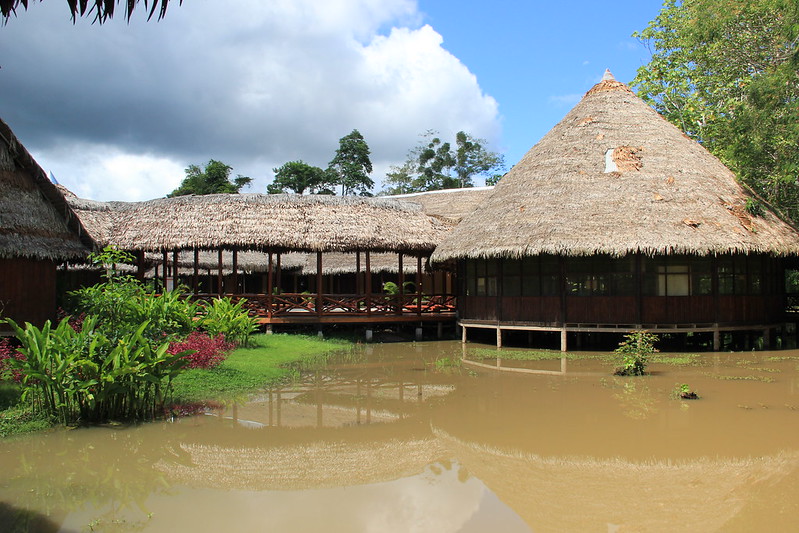
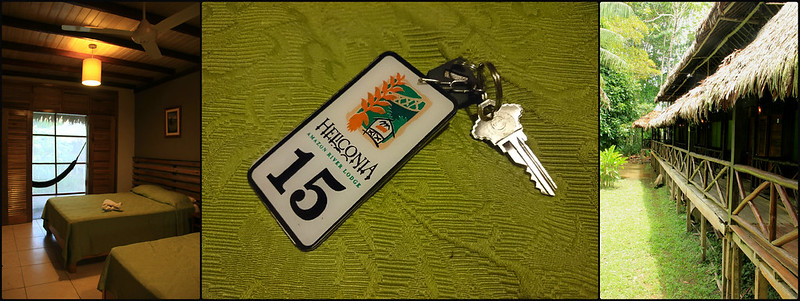

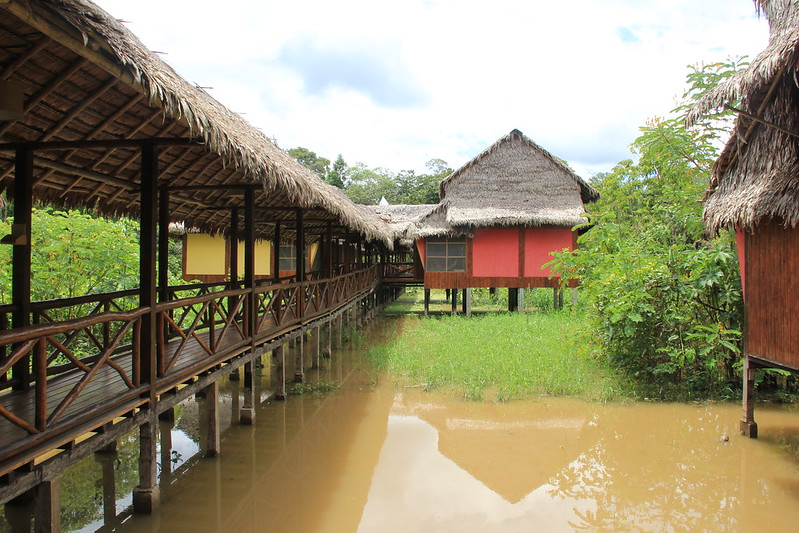
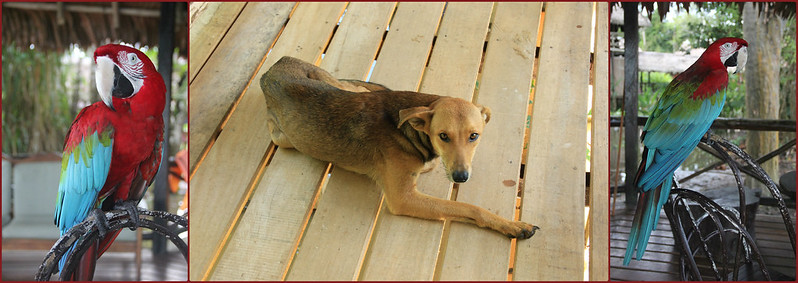

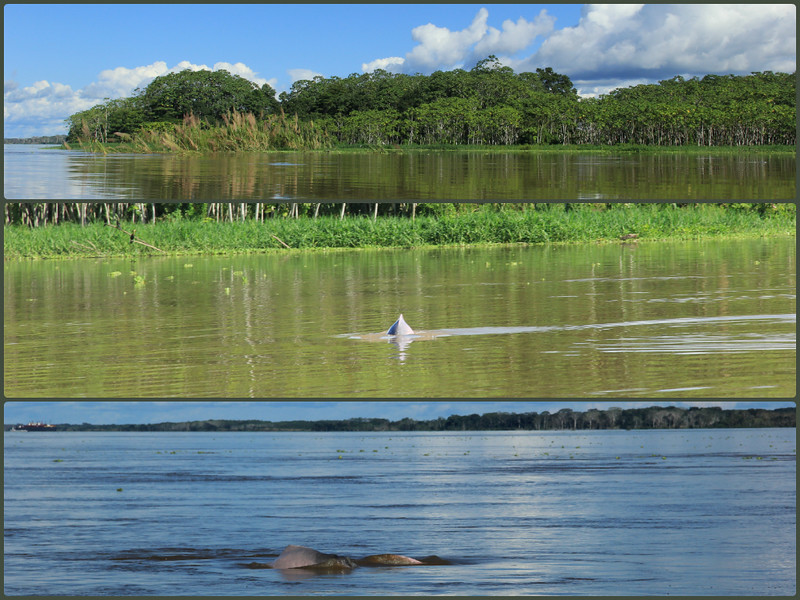
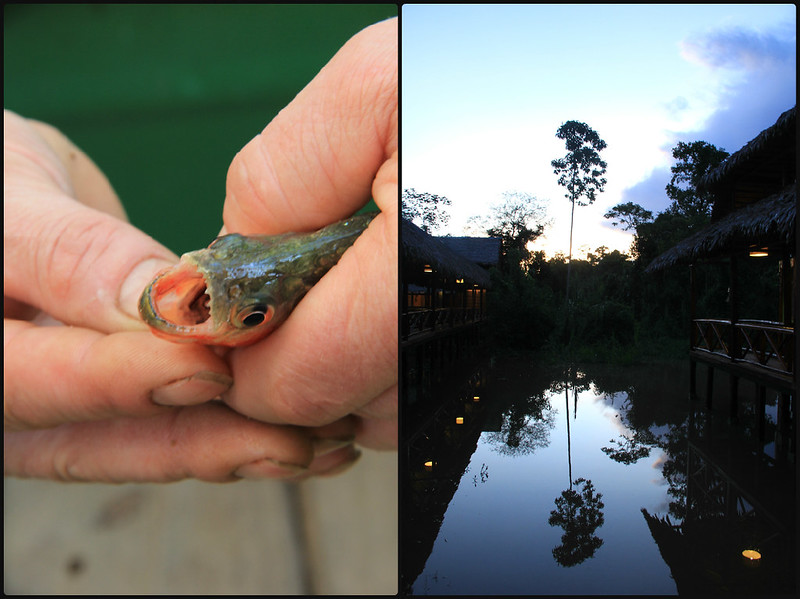






8 Comments
I’ve been wanting to visit for Amazon for FOREVER, ever since one of my good friends went and told me all about it. He told me about the pink river dolphins too!! I would love to see that! And I can’t even imagine what piranhas taste like.. but they look pretty good. 🙂 I really really hope I can do this someday too!
The Amazon had been on my list for a pretty long time too, Anna. So as soon as we planned our trip to South America, it was one of the first excursions we booked 🙂
Oh it’s been an age since i have read your blog – why, why, why? I forgot how much of a smooth storyteller you are. And great photos I wanna eat that fish. Thanks for linking up with us for #SundayTraveler again.
Compliments like that really make me smile, thank you SJ 🙂 Yeah, I’ve been a bit quiet on the Sunday Traveler front due to poor wifi connection in Peru and Bolivia, but now I’m back home I plan to participate on a regular basis 🙂
What a cool experience! I think I would be uncomfortable with the exploitation of the tribe as well. But is it exploitation if they choose to do it? Maybe it is a stretch, but is it no different that people just going to do their job, except here it has a bit of cultural aspect to it? Otherwise, it sounds like the perfect start to a great Amazonian adventure. I’m going to have to read your part 2!
I agree Adelina, which is why I suggested that the fact that they’re capable of living off the land does not necessarily mean that’s all they want, and that maybe they use the money from the cultural performances to put towards a better house or education for their children. So I guess in that sense, yes it’s much like a job for them 🙂 Hope you enjoy part 2!
Hello, on behalf of Christa, host of The Sunday Traveler, I was stopping by to check out your article. Looks like quite an adventure and an amazing way to spend a couple of days. Great pictures too. I must say I’m not afraid of boating or the water but boating upon water that has piranhas in it, definitely concerns me. Lol
Yeah, I must admit I was rather concerned about the prospect of hauling in my catch, but fortunately for me the piranhas wriggled off the hook before I had the chance to! Our guide and also my boyfriend were a little more adept at holding the creatures (once caught) in such a way that they didn’t try to eat you! Don’t think I’ll ever be a fisherwoman….;-)